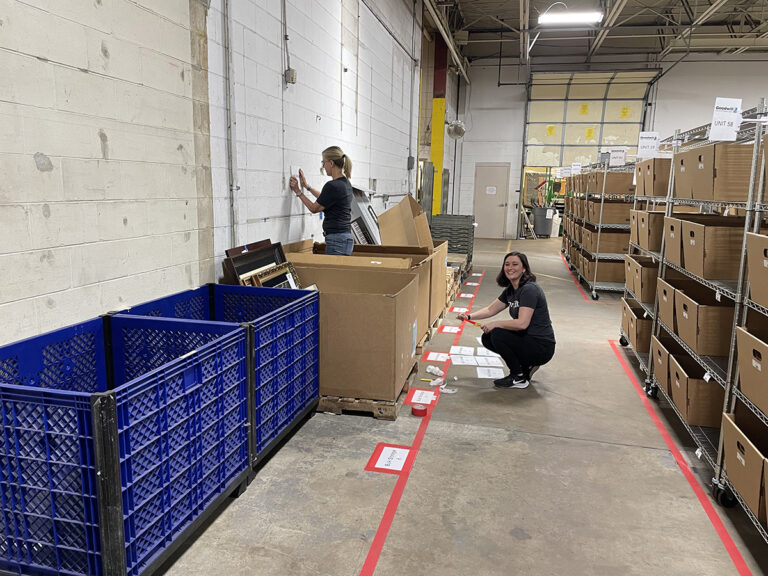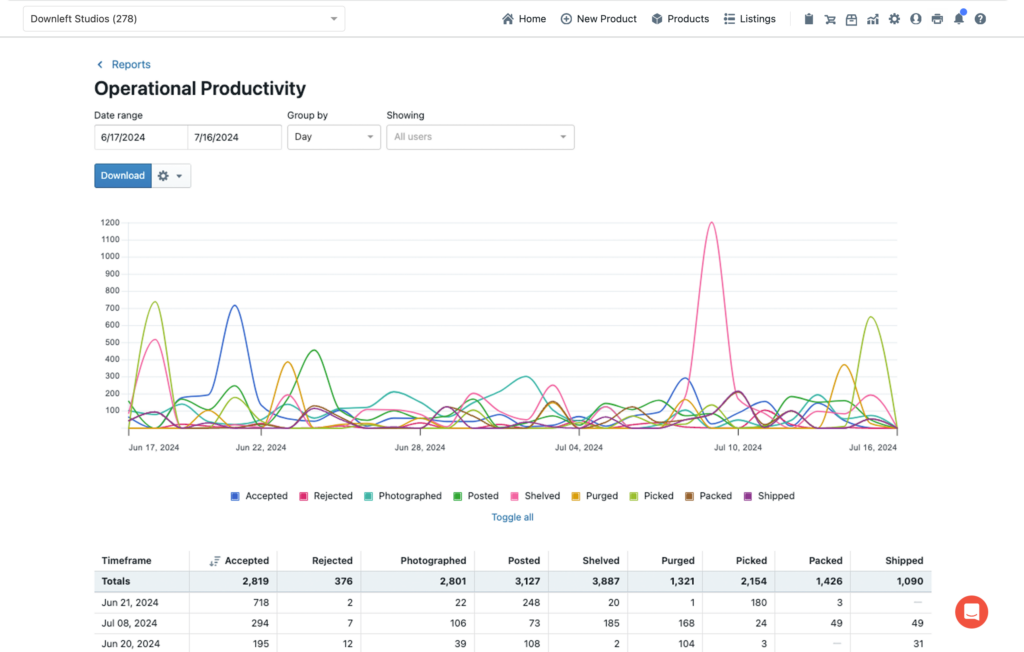In the fast-paced world of secondhand and thrift e-commerce, efficiency isn’t just a goal—it’s essential. Visual management emerges as a game-changing approach that transforms the way teams collaborate and operate. Picture a workspace where every team member is aligned, tasks are clearly defined, and progress is visible at a glance. This method brings clarity and focus, making it easier to streamline workflows, enhance communication, and ultimately boost productivity.
Optimizing team workflow is critical when businesses manage diverse SKUs and operational complexities. Visuals are powerful communication tools; research shows that 65% of people are visual learners, and we retain 83% of what we learn through sight. Effective visual management enhances clarity and understanding, enabling teams to coordinate their efforts more efficiently. By leveraging visual management techniques, businesses can ensure that every member is equipped to tackle their responsibilities with clarity, fostering a more efficient operation that reduces bottlenecks.
To gain a thorough understanding of how visual management can benefit your team and operations, be sure to explore our comprehensive 24-minute E-Commerce Master Class session: Empower Team Workflow Through Visual Management.
Understanding Visual Management in E-Commerce
Visual management is a powerful approach that enhances communication and efficiency within teams by using visual cues to convey information at a glance. It is about immediate recognition and the ability to take immediate action. It plays a vital role in lean management practices by simplifying work processes into clear, actionable insights. For instance, a common visual management principle is the use of color coding—where “red means bad” and “green means good”—which helps teams quickly assess performance and identify areas for improvement.

The concept of “Lean” originated in the manufacturing sector, particularly within the Toyota Production System (TPS). This innovative framework focused on maximizing efficiency and minimizing waste, using visual tools to streamline operations. Over time, these principles have evolved and found their applicability in the fast-paced world of e-commerce. By adopting visual management techniques, e-commerce businesses can enhance their workflows, improve team collaboration, and respond swiftly to customer needs, ultimately driving better operational outcomes.

Benefits of Visual Management for Secondhand E-commerce
Time Savings and Efficiency
Visual management significantly cuts down the time needed to understand and process information. An effective visual management tool should communicate the status of the work area in seconds. This means that team members can walk up to a workstation and quickly grasp what is happening at a glance. With this clarity, teams can dedicate more time to addressing emerging problems or removing roadblocks, ultimately enhancing productivity and operational effectiveness.
Real-Time Problem Solving
Visual management establishes an environment where leaders can assess productivity targets, sales goals, and current and emerging roadblocks in real-time. This visibility allows teams to course-correct quickly if a problem arises, preventing issues from escalating. For example, if a team member is running low on product, a visual cue can signal the need for restocking before productivity halts, enabling swift action to maintain workflow efficiency.
Enhanced Accountability and Communication
Visual management enhances accountability by clearly defining roles, allocating tasks, and providing standardized work procedures. This clarity fosters ownership over daily tasks, encouraging team members to engage more fully in their responsibilities. As a result, the overall performance of the team naturally improves, as everyone works collaboratively towards common goals with clarity and purpose.

Strengthening Team Communication through Visual Management
Leadership’s Role
Leaders must clearly define standards and expectations for overall warehouse practices and each department. Whenever possible, they should be centrally located on the floor, actively engaging where the work is happening. This hands-on approach allows leaders to quickly identify and eliminate roadblocks—when a team member “goes red,” it’s crucial to react promptly. It’s important to remember to lead with empathy, focusing on process improvements rather than placing blame on individuals. Accountability is essential, so leaders should immediately address any deviations from the established processes the team has developed. By working with a sense of urgency and leading by example, leaders cultivate an environment of clarity and responsiveness that strengthens team communication.
Team Engagement
Engaging team members in the visual management process is equally important. When team members are involved in developing and implementing visual systems—such as the 5S methodology—they gain a sense of ownership over their work. This involvement not only fosters adherence to standardized practices but also encourages collaboration and innovation. By creating a culture where everyone has a stake in the process, communication improves, and team members are more likely to embrace changes and work together toward common goals.

Essential Tools and Practical Applications
Creating a Visual Workflow
Start by creating visibility throughout the workspace. Incorporate clear signage that conveys essential information at a glance, allowing team members to navigate the workspace with ease. Utilize floor markings to designate pathways, work areas, and storage locations, which helps prevent ambiguity about where tasks should be performed. These markers should be easily recognizable and designed to communicate status or issues at a glance, thereby reducing response times to roadblocks that arise over time.
Additionally, defining specific workstations with designated tools and materials streamlines processes and clarifies roles and responsibilities. For an example of effective visual workflows, check out our case study on Goodwill of Delaware and Delaware County, which showcases successful implementations in a real-world setting.
Utilizing Tools like Andon Lights
Incorporating visual tools such as Andon lights or color-coded cards can further enhance team communication by providing real-time updates on productivity and operational needs. These tools allow team members to signal their current status using color-coded indicators, ensuring that everyone can stay aligned and responsive to workflow demands and support others where needed.
Dashboards and Reports
Upright Labs’ software integrates various visual management features, including dashboards and reporting tools that enhance operational efficiency. These features enable teams to visualize key metrics and track progress in real-time, with the ability to quickly see inefficiencies that need assistance. If you’re interested in diving deeper into this topic, consider attending our upcoming October 2024 Master Class on Reporting Tools. This session will provide valuable insights into leveraging data for improved team performance and productivity.

Implementing Visual Management: Best Practices
Setting Up Visual Standards
Begin by implementing consistent labeling for all items and areas, which helps team members quickly identify where tools, materials, and tasks belong. Clearly defined zones for specific tasks—such as packing, sorting, and inventory—further enhance organization and streamline workflows. Consider using color coding and standardized symbols to create a visual language that everyone can easily understand. This not only reduces confusion but also promotes a more efficient work environment.
Continuous Improvement
Visual management is not a one-time effort; it requires an ongoing commitment to continuous improvement. Regularly review and adjust your visual management practices to adapt to changing operational needs. Solicit feedback from team members to identify areas for enhancement, ensuring that your visual systems remain relevant and effective. By fostering a culture of adaptability, you empower your team to respond proactively to challenges and maintain high levels of efficiency and productivity. Emphasizing continuous improvement ensures that your visual management strategies evolve alongside your operations, keeping your processes optimized.

Key Takeaways and Next Steps
Visual management offers numerous benefits that significantly enhance efficiency, communication, and overall team workflow. By implementing clear visual standards, organizations can streamline operations, foster accountability, and quickly identify and address issues before they escalate. These practices create a more cohesive and responsive work environment, ultimately driving productivity and team performance.
If you’re ready to take your operations to the next level, we invite you to watch our full 24-minute Master Class session for deeper insights and actionable strategies on implementing visual management effectively.


